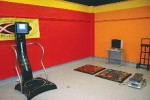Fighting obesity with video games

A group of eager 9- and 10-year-olds from the Kiran C. Patel Charter School entered the XRKade Research Lab’s red, yellow and orange paint-splashed interior yesterday to give its high-tech video-game fitness equipment a try. It met with the children’s seal of approval.
The doors of the lab, the first university interactive children’s fitness research center, opened in the USF Physical Education Building on Monday.
“The kids were all smiles,” said Arron Prather, a fifth-grade teacher at the Patel School who also works as a private trainer with USF athletes. “They’ve found a way to get kids to exercise without even realizing it.”
The lab’s interactive fitness system, called exergaming, combines video games and state-of-the-art fitness and training equipment. Specifically tailored for children, it includes simulator, virtual reality and plug-and-play games such as X-board, a professional-grade snowboarding simulator, and Cateye Gamebike, a plug-and-play video game allowing users to control the movements of an onscreen bike with their entire body.
Exergaming zones such as the one at USF possess great potential for combating childhood obesity and other health problems because they engage children so well, said Lisa Witherspoon, who worked with USF School of Physical Education Director Stephen Sanders and iTech Fitness – a Denver-based company specializing in exergaming – to bring the lab to USF.
“It’s a big step in the right direction in the fight against childhood obesity,” said Witherspoon, who is also an instructor in the School of Physical Education.
According to a study by the National Center for Health Statistics, more than one in six adolescents in the United States are overweight, which is more than triple the rate from 1976-1980. Childhood obesity can lead to high blood pressure, high cholesterol and diabetes later in life. According to a projection by the Centers for Disease Control and Prevention, it is expected that one in three children born in the United States five years ago will become diabetic.
Additionally, the cost of treating obese children and the obese adults they grow into taxes the health care system. The annual health care costs of obese children outpace the costs of their healthy peers by an average of $172 per child, according to a 2007 study by researchers at the University of Missouri-Kansas City School of Medicine.
Recognizing these trends and the possibilities exergaming holds for improving them, public school systems, YMCAs and private fitness clubs across the country have moved toward creating interactive fitness zones. But little comprehensive research of exergaming’s effects on the activity levels and physical fitness of children exists, Witherspoon said. That’s something that the School of Physical Education hopes to change.
“I know it works,” Witherspoon said. “I’ve seen it. I’ve observed it. Now it’s just a matter of making it a little more concrete.”
Witherspoon said the focus of the research and the methods used still need to be discussed and evaluated by researchers in the School of Physical Education, but the decisions about the research’s direction will begin with getting feedback from the kids. These efforts will begin in earnest with the lab’s grand opening, which is slated for Jan. 26.
iTech Fitness, an industry leader in designing interactive fitness equipment and exercise environments, donated nearly all of the $45,000 worth of the lab’s exergame equipment.
“We want to be in the business of making exercise fun for children,” iTech Fitness CEO Mike Hansen said.
Although the iTech equipment in USF’s lab is child-focused, kids aren’t the only ones who can get a good workout. Prather, a former Olympic qualifier in the 200-meter dash, said the equipment could be set to levels challenging even him.
“I think this is the future of exercise training technology,” Prather said.





